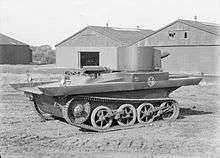Vickers-Carden-Loyd Light Amphibious Tank
| Vickers-Carden-Loyd Light Amphibious Tank | |
|---|---|
 | |
| Type | Amphibious tank |
| Place of origin |
|
| Service history | |
| Used by | see text |
| Production history | |
| Designer | Carden-Loyd Tractors Ltd. |
| Manufacturer | Vickers-Armstrong |
| Produced | 1931–1932 |
| Specifications (A4E11, A4E12) | |
| Weight | 2.17 long tons (2.20 t) |
| Length | 13 ft 4 in (4.06 m) |
| Width | 6 ft 9 in (2.06 m) over tracks |
| Height | 6 ft 2 in (1.88 m) |
| Crew | 2 |
|
| |
| Armour | 11 mm (0.43 in) |
Main armament |
0.303 inch Vickers machine gun with 1,000 rounds |
| Engine |
Meadows petrol 6-cylinder 90 bhp |
| Suspension | Horstmann |
Operational range | 100 mi (160 km) |
| Speed | 27 mph (43 km/h) on road; 3.72 mph (5.99 km/h) in water |
The Vickers-Carden-Loyd Light Amphibious Tank (designated the A4E11 and A4E12 by the War Office),[1] was a series of British experimental pre-World War II light tanks (actually resembling a tankette, which though not taken into British service were sold to a number of other countries which produced modified versions which were then taken into service.
Foreign buyers included China, Thailand, the Dutch East Indies and the USSR, the latter producing some 1200 of the T-37A tank developed from the A4E11/12. Poland was interested in Vickers-Carden-Loyd amphibious tank in the 1930s, but negotiations failed and instead the PZInż works started the PZInż 130 project, an indigenous design inspired by the British concept.
Notes
This article is issued from Wikipedia - version of the 11/4/2016. The text is available under the Creative Commons Attribution/Share Alike but additional terms may apply for the media files.